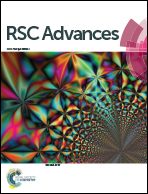Ultradispersed titanium dioxide nanoparticles embedded in a three-dimensional graphene aerogel for high performance sulfur cathodes†
Abstract
Lithium–sulfur (Li–S) batteries are regarded as one of the most promising energy storage technologies, however, their practical application is greatly limited by a series of sulfur cathode challenges such as the notorious “shuttle effect”, low conductivity and large volume change. Here, we develop a facile hydrothermal method for the large scale synthesis of sulfur hosts consisting of three-dimensional graphene aerogel with tiny TiO2 nanoparticles (5–10 nm) uniformly dispersed on the graphene sheet (GA–TiO2). The obtained GA–TiO2 composites have a high surface area of ∼360 m2 g−1 and a hierarchical porous structure, which facilitates the encapsulation of sulfur in the carbon matrix. The resultant GA–TiO2/S composites exhibit a high initial discharge capacity of 810 mA h g−1 with an ultralow capacity fading of 0.054% per cycle over 700 cycles at 2C, and a high rate (5C) performance (396 mA h g−1). Such architecture design paves a new way to synthesize well-defined sulfur hosts to tackle the challenges for high performance Li–S batteries.



 Please wait while we load your content...
Please wait while we load your content...